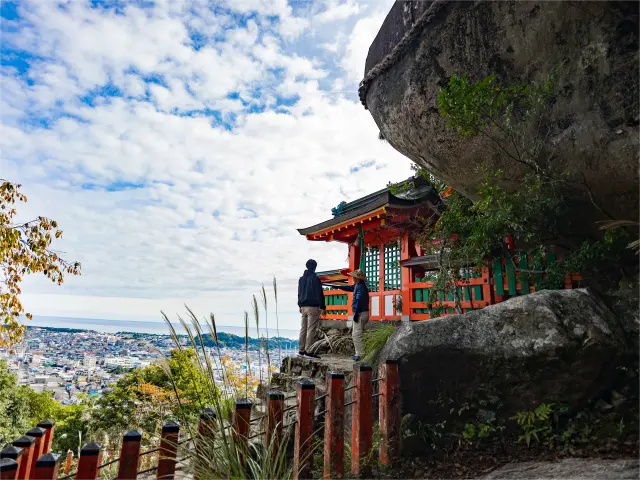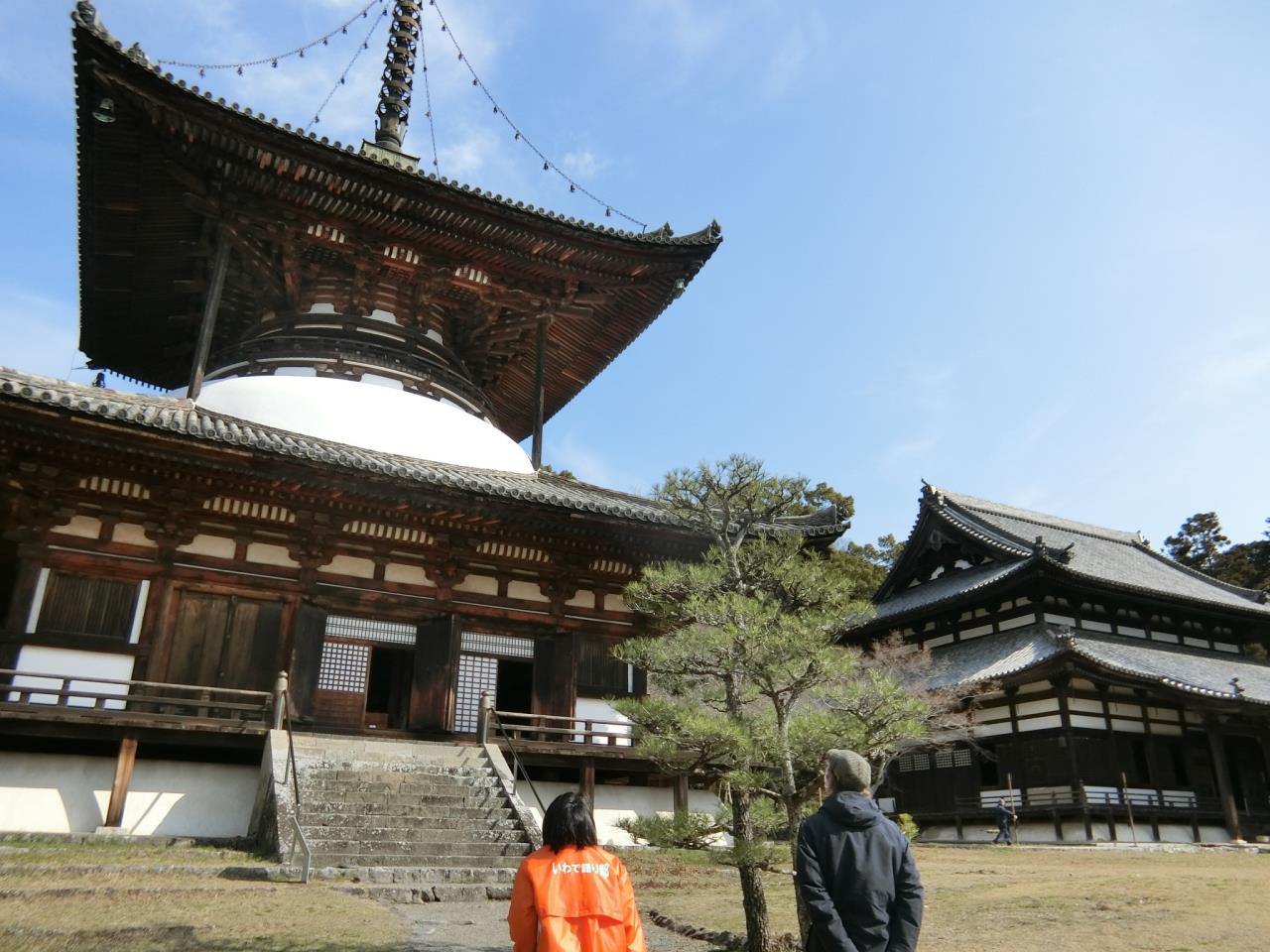
Castles, Temples and Gardens in Wakayama, day 2
Last update
Day two of our tour of gardens and temples in North Wakayama started with breakfast looking up at Wakayama Castle, sparkling in the sun above the park at its foot. Until just 150 years ago this park held the extraordinary living quarters of the Kishu-Tokugawa family. Sadly they are long gone now, but from my breakfast seat I could see the reconstructed Ohashiroka Bridge, an unusual sloping bridge with walls and a roof, built so the lord could cross the moat from the women’s living quarters to the Nishinomaru area without being seen. The bridge was reconstructed in 2006 from the original plans, which are on display in the Wakayama Historical Center, and appear so precise and modern it is hard to believe they were drawn up hundreds of years ago. Beyond the bridge are the Nishinomaru gardens, which were first created at the beginning of the Edo period in the early 1600s, and are particularly spectacular in autumn when the maples become a blaze of reds and oranges.

Negoro Temple
Our journey was to take us east, following the course of the Kinokawa river, to Iwade, Kinokawa City, and then on to Koyasan. The first stop was Negoro temple, in Iwade, where we were met at the en-trance by Megumi Ito who was to be our guide.
The history of Negoro temple goes back over 900 years. Originally founded in 1132 as a center for studying buddhism in Koyasan, in 1140 the famous priest Kogyo-Daishi moved from Koyasan to Nego-ro to restore the Shingon sect of Buddhism. The center prospered and at its peak had around 2700 tem-ples in its grounds, until it was burnt to the ground in 1585 by the great lord Toyotomi Hideyoshi who feared Negoro temple's powerful influence would undermine his control. In 1623, shortly after he had completed the first improvements on Wakayama Castle, Tokugawa Yorinobu ordered the reconstruc-tion of the temple, and throughout the Edo period it flourished once more. Today the temple complex covers close to 300 acres, and is especially spectacular in the spring when the cherry blossom are in full bloom. The day we visited the buds on the cherry trees were so plump they seemed ready to burst into flower at any minute, but sadly we were a bit too early for the full effect. Even so, in the bright spring sunshine the temple grounds were a delight to wander through, as Ito-san led us up to the main temple buildings.
In the center of Negoro Temple is a 40m high, two-tiered wooden pagoda. Completed in 1547, it is be-lieved that work began on the tower in around 1480, meaning it took nearly 70 years to complete. Happily it escaped Hideyoshi’s fires making it the largest wooden pagoda of its kind in Japan, and a des-ignated national treasure. The 15m-wide square base of the pagoda transforms into a white plastered dome, taking its inspiration from an Indian stupa, and on to a cylindrical tower above, and the con-struction of wooden beams and joints from square to round is extraordinarily complex. The square ground floor hall, too, contains a circular buddha hall within it, complete with curved paper screens, that holds a spectacular three-dimensional mandala of buddha statues centering on the Dainichi Nyorai himself.
Next to the pagoda is the Great Hall, which was reconstructed in 1826. The hall holds three much older gold-lacquered buddha statues that were made in 1405, centering on another three meter high Dainichi Nyorai. Dainichi Nyorai is the most important buddha in Shingon, said to hold the truth of the universe. The hand gestures of buddha statues each hold a separate meaning and across Japan the Dainichi Nyorai can be seen with various different hand gestures, some used by other buddhas as well. But the “chikenin” pose symbolizing great wisdom, with the right hand grasping the extended left forefinger, is only used by the Dainichi Nyorai, so if you see that pose you can be sure which buddha you are looking at.
As we moved on to the next spot, we stopped at a stone inscription carved into a large garden rock. If Ito-san hadn’t stopped us we would undoubtably have walked past without noticing it, but once we had stopped she broke into a slow, lyrical song. The song was a Negoro lullaby, a local tradition of folk songs with lyrics that mention Negoro Temple, that goes back hundreds of years and is still maintained to this day. There are many variations of the song, but the lyrics to one of the most popular versions was carved into the rock.
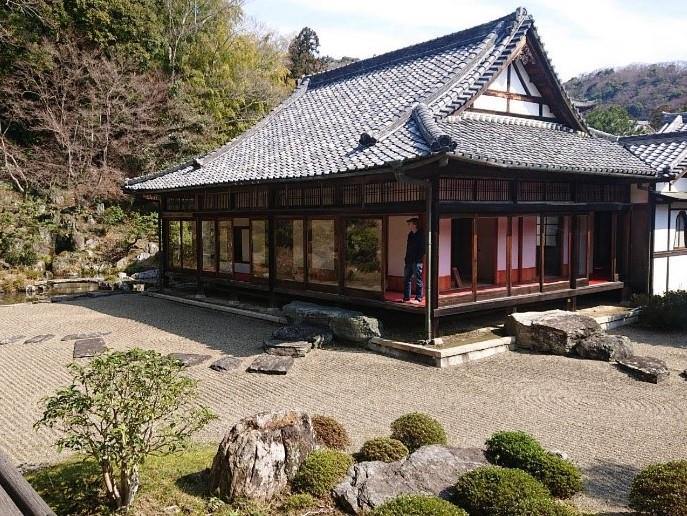
Meisho Garden and Nagusa Goten
A short walk from the lullaby rock is the main office buildings of the temple, and at the back is Nagusa Goten, a small building that was once in the grounds of Wakayama Castle but was relocated to Negoro by the eighth Kishu-Tokugawa lord Tokugawa Shigenori. The simplicity of the building belies its so-phistication, and once inside although there are no elaborate details it is clear this is a building made for a lord. Surrounding it on three sides is a garden that was completed in 1801. On two sides the garden is of raked gravel with carefully placed rocks and just a hint of greenery, and to the other a pond and rock garden that blends up into the hillside and natural forest above. As with most Japanese gardens, the sparse design is filled with symbolism, offering different layers of enjoyment and leaving plenty of space for you to project your own interpretation. The main feature of the garden is the three-tiered dragon waterfall climbing up the bank into the woods, from the Chinese legend of the carp that turned into a dragon as it swam up the rapids. Below in the pond are rocks symbolizing a crane and a turtle, though you would be hard pushed to recognize either. Beyond the symbols though, even in early spring when flowers are few and branches are still bare, the garden is a soothing oasis, and it is easy to imagine Lord Shigenori sitting here on the veranda, relaxing after his duties.
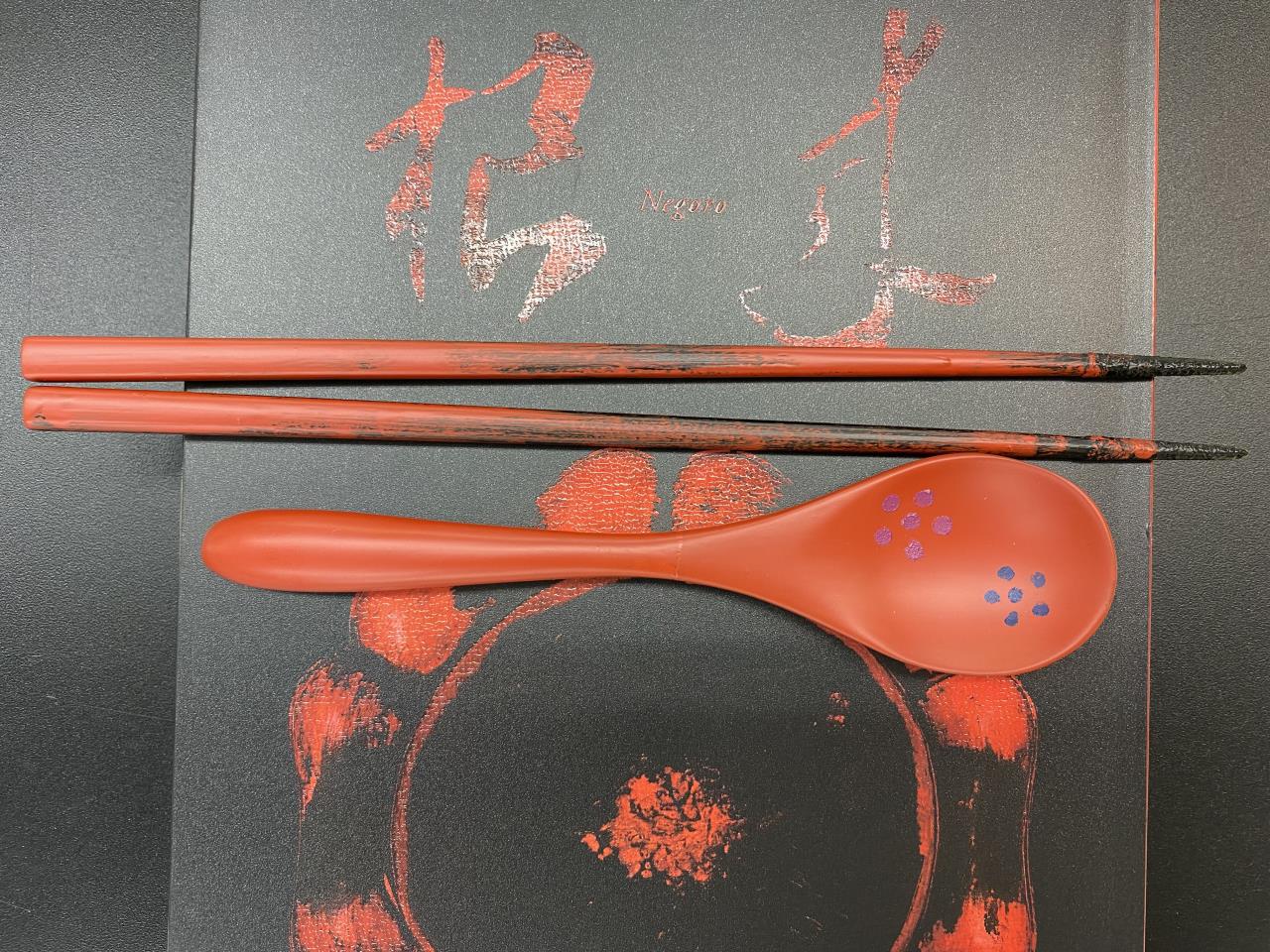
Negoro Lacquerware Experience
Leaving the garden behind, we turned our back on the temple buildings and walked a little further through the trees until Ito-san stopped at a small building. Although Ito-san works as a temple guide, her real job is as a lacquerware artisan, and this was her small workshop, set deep in the temple grounds. The history of Negoro lacquerware goes back to the 12th century, when the area was inhabit-ed by thousands of monks who needed tableware. The very best of this lacquerware used brilliant vermillion cinnabar lacquer, which rather than having the familiar smooth and gleaming lacquer finish, held the marks of the artisan’s brush, and over years of use the red would wear away revealing bold traces of black lacquer underneath. This red lacquer with black markings was to become the hallmark of Negoro lacquerware, and the worn bowls and utensils became highly prized in Wakayama and be-yond. But when Toyotomi Hideyoshi burnt down Negoro Temple in 1585, the lacquerware industry was moved to Kuroe and spread across Japan, and it wasn’t until over 400 years later that it would be revived in Negoro. Today, Ito-san is one of only a handful of Negoro lac-querware artisans active in the area.
On entering her workshop you are immediately struck by the warm, sweet smell of natural lacquer and turpentine common to lacquerware studios. The back of the space is filled with several large, heav-ily-constructed wooden chests. These are the “muro” where Ito-san dries her works between each stage in the painstaking process of lacquering a bowl or dish. At the front of the space is a work desk, and here Ito-san will guide you through the process of lacquering your own spoon or set of chopsticks in the design of your choice. It is simple enough, and highly satisfying to paint a stripe or motif on a pair of your very own chopsticks. But it requires an entirely different level of expertise to gradually build up the layers of lacquer, drying them each time before applying another, and produce the exquisite fin-ish of Ito-san’s finest work. It’s easy to understand why her more expensive pieces sell for thousands of dollars.
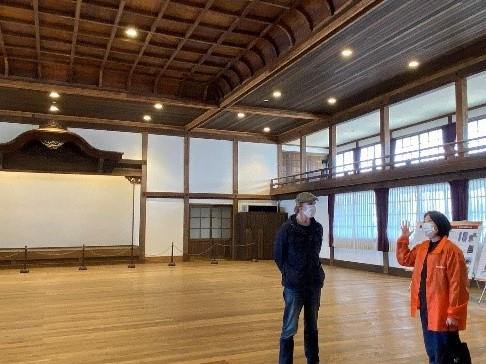
Old Wakayama Assembly Hall
After our lacquering experience we left the Negoro Temple complex and took a short walk along the main road to the Old Wakayama Assembly Hall. This impressive building was once the Assembly Hall of the Wakayama Prefectural Government, and when it was due to be torn down in 1938 to make way for larger more modern buildings, the people of Iwade purchased it, and in 1962 it was rebuilt in the Negoro Temple grounds. It stood there for many years until it was recently relocated once again and fully restored on the current site. Originally built in 1898, the building is in a Japanese architectural style, but the 18m wide main hall, constructed without internal supporting pillars, makes use of a western trussed-roof system to create a vast space that would be impossible with traditional Japanese architectural techniques. The hall is huge, and you can imagine the 19th century politicians fierce in debate in the newly-introduced democratic fashion, with crowds looking on from the spacious visitors gallery that runs above it around three sides.
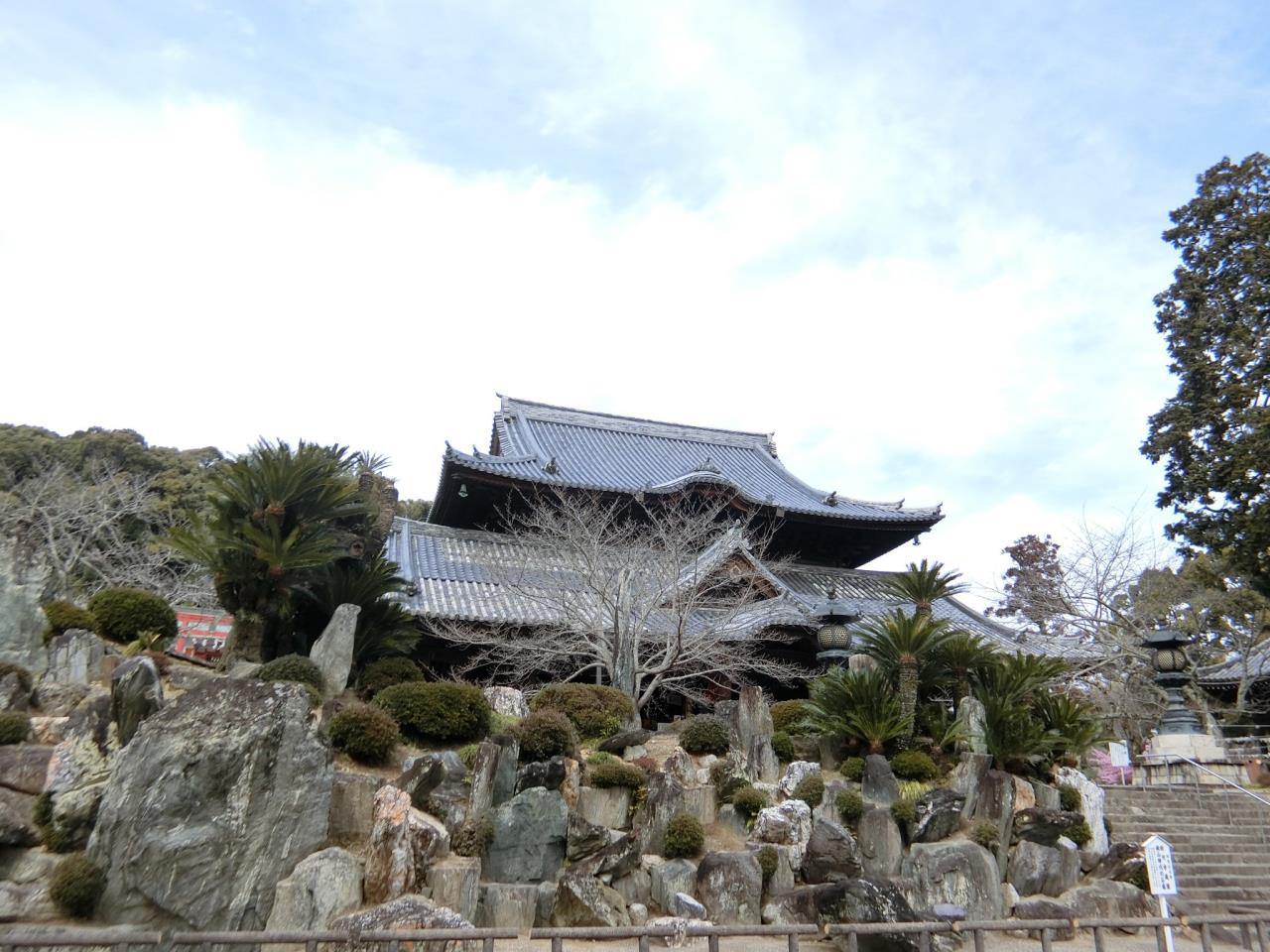
Kokawa-dera Temple
Next we headed up to nearby Kinokawa City, home to Kokawa-dera Temple. The temple is the oldest on our trip so far, said to have been founded in 770.
According to legend, a hunter named Otomono Kujiko saw a mysterious light in the mountains, repent-ed of killing and built himself a hermitage. He spent his days wishing for a Buddha to be enshrined there.
One day, a child dressed as a pilgrim came to visit him, asking for a place to stay for the night. The next day, the child thanked the hunter for his hospitality and began to carve a statue of Buddha. Seven days passed and on the morning of the eighth day the child disappeared and a statue of the thousand-armed Kannon was left behind. The hunter realized that the child was an incarnation of the buddha, and spent his days in devotion to the thousand-armed Kannon.
The purpose of our visit was to see the garden. Passing through the Daimon main gate, the approach to the Chumon middle gate is lined with various halls. Once through the middle gate, the main hall appears on the far left, and the garden is built on a three-meter step in front of it. The garden was created during the Momoyama period (1573-1603) and is designated as a National Place of Scenic Beauty spot.
It is one of the most unusual and impressive gardens I have ever seen. It is a stone garden, built mainly of Kishu blue stone, on both sides of the stairs leading to the main hall. The massive rocks of different colors, shapes and sizes jutting out from the slope at steep angles are perfectly balanced, giving the gar-den an incredible amount of depth despite it only being a few meters deep, with azaleas and sago palms scattered among the rocks, and a single juniper towering over the edge. It takes a while to focus your eyes, but once they adjust, familiar symbols emerge from the rocks. There is the stone bridge over a dry landscape waterfall, just like the one I saw in Negoro. And there, too, is a crane stone and a turtle stone among the rocks.
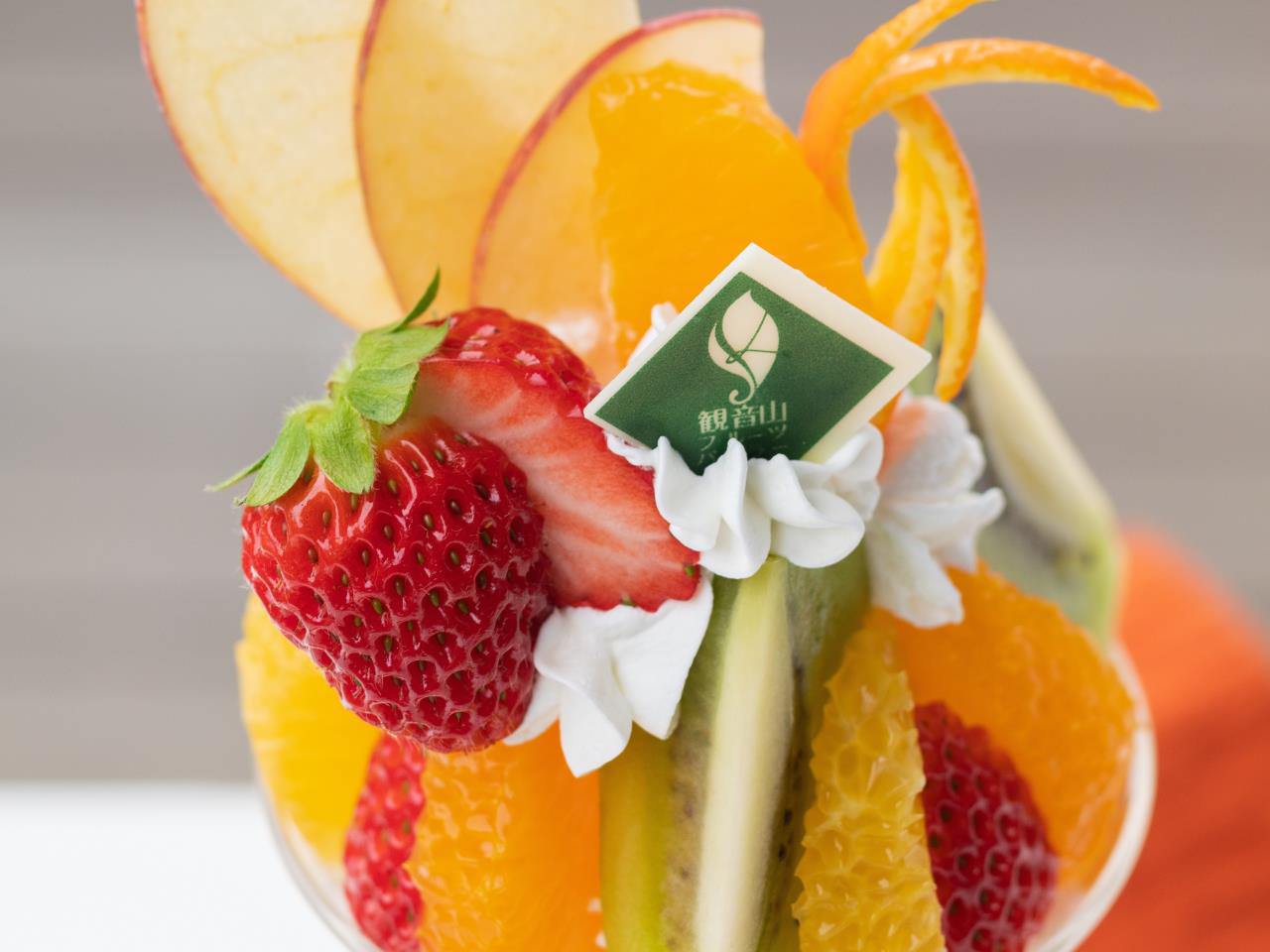
Kannonyama Fruit Garden
The main goal of our trip this time was Japanese gardens, but no trip to Wakayama would be complete without an injection of fruit. Wakayama is famous for fruit of all kinds, but particularly mikan oranges, and we stopped briefly at the Mekkemon Hiroba Farmer’s Market to see what was on offer. The Japa-nese countryside is dotted with wonderful farmer’s markets, but perhaps none have the amazing quali-ty and quantity of fruit as Mekkemon. The warehouse store was filled with row after row and box after box of oranges, satsumas, tangerines and every kind of citrus fruit you could imagine. As the seasons change so the type of fruit on sale changes too, but there is hardly a time of year when Mekkemon isn’t brimming with gorgeous, top quality fruit.
To find out where some of it comes from and how it is grown we visited Kannonyama Fruit Garden. Owner Fumio Kodama waved to us from his truck as we drove in, and the minute we were out of the car he had jumped out too and was leading us up the steep hill behind the farm shop to the banks of cit-rus trees. Ignoring the “don’t pick the fruit” signs on all the trees (he is the owner after all) Kodama-san reached in and grabbed us handfuls of oranges to try, skillfully prizing them open with a quick squeeze of his thumb and passing the dripping fruit to us, and to all the other passing visitors as well. Kodama-san is a big man full of laughter, and his enthusiasm and obvious love for his work was infectious. We rinsed our hands of the sweet juice as he led us into the upstairs restaurant area of the shop, situated slap bang in the middle of the orchards. In no time at all we had a selection of the largest fruit parfaits you can imagine in front of us, and it took no persuasion at all for us to dig in. And boy were they good. It was easy to see why the shop was so popular even on a weekday and despite its location half way up the mountain away from town. After gorging ourselves on fruit and cream, we went downstairs to the farm shop. Here a team of fifteen or so young employees, mostly in their twenties, were energetically filling box after box with every kind of orange and lemon you can imagine - orders to be sent all over Japan. Before we knew it we had been handed a bag of oranges each - a slightly heavy but much appre-ciated gift.
And so we climbed back in our car and set off to our final destination, Koyasan itself, and a night at a temple lodgings.
Check also...
![Take a leisurely stroll in the retro and fashionable space [Kuroe, the town of Kishu lacquerware]](/kansaiguide/data/article/21000/20278/20250618_133123_770e1e88_w640.webp)
Take a leisurely stroll in the retro and fashionable space [Kuroe, the town of Kishu lacquerware]

Consider your accommodation in the Kansai area!

Restrictions on Large Baggage

Hidden Stories in Stone: Exploring Japan’s Castle Walls

Feel Like a Lord: Castle with Stunning Panorama Views

Experience the True Essence of Japan through Castles, Cultural Treasures, and Timeless Gardens
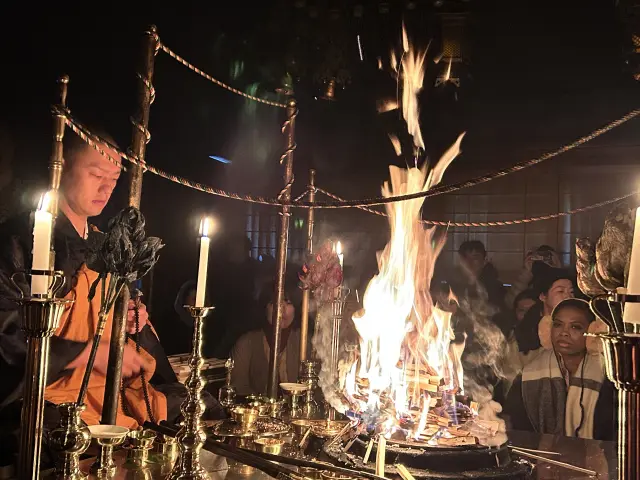
Departing from Osaka, Exploring Wakayama and Tokushima: A Journey Connecting Mountains and Sea with a Focus on Mindful Sustainability
